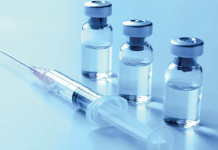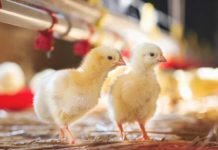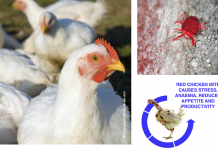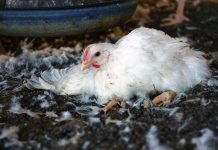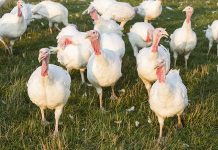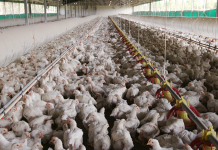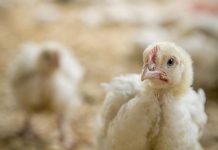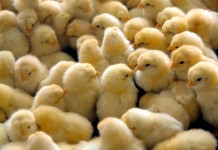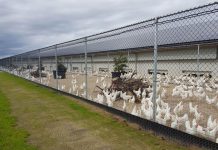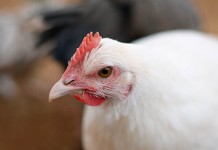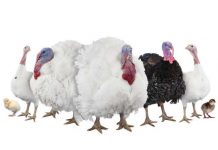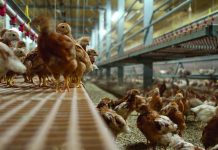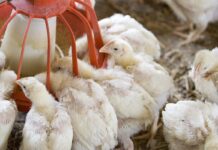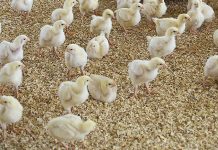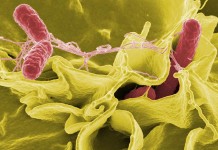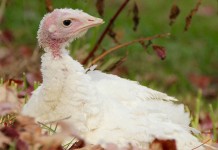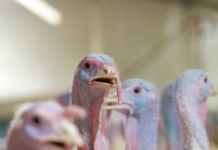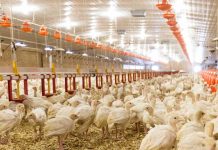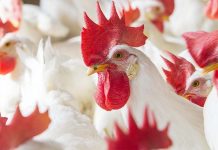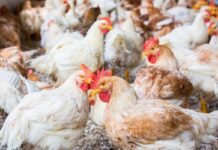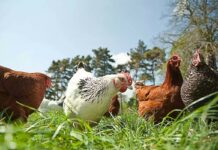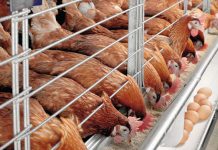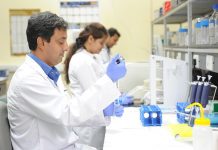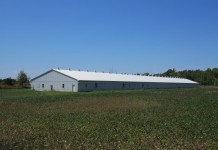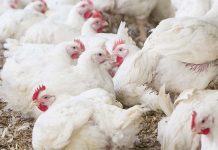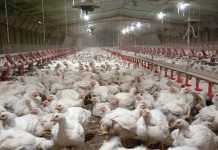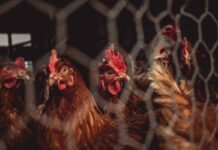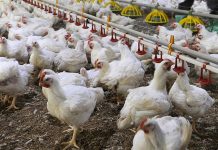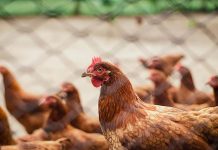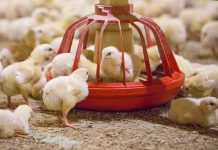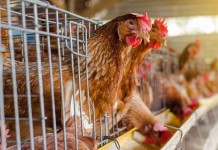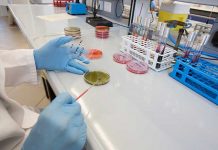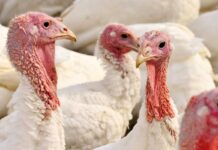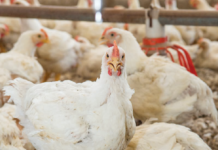Bacterin usage
A good vaccination program, along with proper flock management and biosecurity, plays a key role in the health and productivity of broiler breeders. The...
Future of coccidiosis management in turkeys
Coccidiosis is a disease that is caused by protozoan parasites that develop within the intestine of most domestic and wild animals and birds. Coccidia...
Mycoplasma Synoviae, a technical update
Mycoplasma are the smallest free-living organisms both in size and number of genes, and unlike many other bacteria, they do not have a cell...
Managing coccidiosis in birds raised without antibiotics
For poultry producers to make a profit they must have healthy, uniform sized birds, make sure there are no real or assumed human health...
Alternatives to antibiotics in organic poultry
Organic poultry production is one of the fastest growing segments of organic agriculture with a 20% average annual increase since the establishment of the...
Monitoring of IBV circulation and prevalence
Infectious bronchitis (IB) is one of the most common viral diseases in chicken production worldwide and IB virus (IBV) is considered the most contagious...
Advantages and disadvantages of Coccidiosis control programs in poultry
Coccidiosis is a protozoan economic disease of poultry, in which around 80% of losses are due to mortality, reduced weight gain, inefficient feed conversion,...
Prevention and control of biofilm in water line systems as part of biosecurity protocols
This paper does not address
the situations in which the microbiological quality of the water
has been compromised from the beginning; rather, this paper addresses how
drinking...
The cost of mycoplasma infection in poultry
Sometimes some Mycoplasma infections cause disease in poultry and this has been extensively studied and worried about by veterinarians, poultry producers and veterinary authorities....
Backyard poultry flocks Salmonella spp. seroprevalence
As backyard poultry grows as a hobby in the United States there is an increased worry that poultry will become infected with Salmonella spp....
Holistic view of intestinal health in poultry
Intestinal health is necessary to maintain efficient and sustainable gastrointestinal tract (GIT) physiology. The GIT has digestive, absorptive, metabolic, immunological and endocrinological functions.
This means...
The challenges and future of poultry diagnostics
A review of the past helps to frame the future of poultry diagnostics. In the United States, the Land-Grant universities provided a fertile environment...
Turkey reoviral arthritis update
Avian reoviruses (ARVs) belong to the genus orthoreovirus in the family Reoviridae. They are nonenveloped, double-stranded RNA viruses that are ubiquitous in domestic poultry...
The role of feed additives in the protozoal diseases in poultry
Coccidiosis and histomoniasis are economically significant diseases in chickens and turkeys. Management, vaccination and medication are key tools in the control of these diseases...
Mycotoxins in turkeys
Toxin production requires the presence of a mould, a suitable substrate and a suitable environment. If a mould is present, toxin production is influenced...
Research Rules Out Possible Kinky Back Prevention
USPOULTRY and the USPOULTRY Foundation announce the completion of a funded research project at North Carolina State University in Raleigh, N.C., in which researchers...
Effect of difference doses of Newcastle disease vaccine immunization on broilers
Influence on growth performance, plasma variables and immune response
As a member of the Paramyxoviridae group, Newcastle disease virus (NDV) is the key causative agent...
Increasing standardization in real-time PCR diagnostics
How to use it with a modular system and its benefit to laboratory throughput.
The IDEXX RealPCR™ real-time PCR reagents aim to provide a new...
Field vaccination against ILT in broiler chickens: lack of consistency
When vaccination against infectious laryngotracheitis (ILT) is necessary in broiler flocks, mass administration techniques are required due to the sheer numbers of birds involved....
Analysis of anti-Ascaridia galli antibody levels in egg yolk to detect parasite infection in...
In recent years, in response to consumer concerns regarding welfare of birds, there has been a move from caged to free-range production systems. This...
Evaluation of factors that affect susceptibility and control of reovirus-induced viral arthritis in broiler...
The USPOULTRY Foundation announces the completion of a funded research project at AviServe LLC in Newark, Del. (USA), that has revealed a new tool for...
Infectious bronchitis virus (IBV) vaccines produced in eggs have unpredictable mutations
Scientists at The Pirbright Institute have shown that infectious bronchitis virus (IBV) vaccines produced in eggs have unpredictable mutations which may be prone to...
Gut health in layers
To some extent gut health has not been a focus of commercial pullet and layer flocks unless the problem contributed to a significant mortality...
The Omics revolution – Implications for animal production
What does Omics mean?
Omics is a term that refers to the recently developed high throughput technologies that include genomics, functional genomics (transcriptomics), proteomics, and...
Testing day-old poults
When poults are received at a farm from the hatchery they should be good quality poults; namely, free from physical defects, actively looking for...
Microbiota studies in poultry
The microbial populations that inhabit the gastrointestinal tract (GIT) of birds play an important role in the establishment and maintenance of a healthy gut....
Poultry expertise at IDEXX
In a rapidly evolving poultry production environment with fewer treatment options, disease prevention and identification are more important than ever. Reliable lab diagnostics play...
Gut health
Gut health and the efficient conversion of feed into its basic components for optimal nutrient absorption is vital for both commercial and turkey breeder...
Coccidiosis control in broiler breeders with the use of vaccines by Aviagen®
Coccidiosis is a disease of the intestinal lining, produced by the invasion of the mucosal cells by a very prolific protozoan parasite of the...
Ability to detect Salmonella vs. Salmonella-Free in poultry processing
Poultry are sampled often for Salmonella during growout on the farm and throughout the processing plant. While on farm sampling is not currently a...
On-farm control of campylobacter
Campylobacteriosis, primarily caused by the consumption of contaminated chicken products, accounts for the majority of food poisoning cases in Europe and many other developed...
Salmonella, creating the most undesirable environment
Background
Salmonella non-typhoidal is among the top foodborne bacteria that cause illness within the United States annually.With 1.4 million illness (11% of foodborne bacteria), 19,336...
The ABCs of CDT (Clostridial Dermatitis of Turkeys)
Clostridial Dermatitis of Turkeys (CDT), also referred to as Cellulitis, remains a major disease issue across all geographic regions of the US; the annual...
Holistic view of intestinal health in poultry
The intestinal health of poultry has broad implications for the systemic health of birds, animal welfare, the production efficiency of flocks, food safety, and...
Novel Approach Improves Poultry Welfare by Reducing Stress on Chickens
MSD Animal Health (known as Merck Animal Health within the United States and Canada) recently announced the launch of EXZOLT® (fluralaner), the first systemic...
The importance of gut microbiota in chickens
Recent expansion in knowledge about the influence of microbiota on health and disease started a major research revolution in the area. Intestinal systems of...
Clostridial Dermatitis
Clostridial Dermatitis is a disease of economic concern in turkeys. Clostridium perfringens and Clostridium septicum have been isolated consistently from dermatitis lesions in turkeys....
Heat stress causes inhibition of Eimeria replication in broilers
Eimeria infection is one of the most important diseases affecting poultry production, and is characterized by bloody or watery diarrhea, weight loss, poor feed...
In-ovo corticosterone alters body composition in 35 day old chi-cken meat birds
Increasing evidence suggests early-life exposure to maternal stress can permanently alter thedevelopment of an embryo. Such findings have significant application to the chicken meat...
Transcriptomic modifications caused by subclinical necrotic enteritis in broiler chickens
Phasing out of in-feed antibiotics in the poultry industry has caused necrotic enteritis (NE) to become a primary concern in commercial poultry production in...
A new poultry research center at the University of Bristol
A state-of-the art poultry research centre offering specialist, industry-focused research into both laying hen and broiler health, welfare, behavior and productivity has recently been...
Isoquinoline alkaloids lower the prevalence of salmonella Heidelberg in broiler chickens
Worldwide, tens of millions human cases are reported every year for salmonellosis. This makes it one of the most common foodborne diseases, which can...
Host and microbial biomarkers for intestinal health and disease in broilers
New tools can be used to determine the gut health status of animals and to predict animal performance or to make a decision whether...
The relationship between sperm function and diet – Toms are what they eat
It is well known that cryopreserved semen could be used to regenerate commercial or research poultry lines; however, fertility rates from poultry semen frozen...
Research provides new understanding of ILT vaccines
USPOULTRY and the USPOULTRY Foundation announce the completion of a funded research project at the University of Delaware in Newark, Delaware, in which researchers...
Blackhead disease: development of molecular tests and an in vitro assay to identify reservoirs...
This research project developed diagnostic assays needed for advancing the understanding of blackhead disease. The article shows clearly how the disease most likely spreads...
Pathogenesis of egg infections by Salmonella – First Part
Salmonella is an invasive bacterial genus and colonizes the gut of chickens, and systemically spreads to internal organs, including the reproductive tract, potentially leading...
Histopathological evaluation of Histomonas meleagridis on ceca and the bursa of Fabricius in turkeys
Histomoniasis is caused by Histomonas meleagridis, a flagellated protozoan parasite. It causes systemic infection in turkeys and induces characteristic lesions in ceca and liver....
Pulmonary Nocardiosis in turkey poults
Nocardiosis is an opportunistic, noncontagious, pyogranulomatous or suppurative disease of domestic animals, wildlife and people. In domestic animals, it causes mastitis, pneumonia (granulomatous lesions...
Improving birds’ health by refining their intestinal microbiota health and stability
Intestinal systems of living organisms are inhabited by a dense community of microorganisms dominated by bacteria but also containing archea, fungi, protozoa and viruses....
Role of dietary calcium in Necrotic Enteritis development and pathogenesis
USPOULTRY and the USPOULTRY Foundation announce the completion of a funded research project at Texas A&M University in College Station, Texas, in which the...
Use of multiple strains of infectious bronchitis vaccines to induce protection against new IB...
USPOULTRY (www.uspoultry.org.) and the USPOULTRY Foundation announced the completion of a funded research project at the University of Delaware in Newark, Del., in which researchers found...
Turkey arthritis reovirus. Diagnostic strategies
Avian reoviruses (ARVs). They are non-enveloped viruses of 70-80 nm size having an icosahedral symmetry. The viral genome has 10 segments of double stranded...
Key global health issues in cage-free and organic laying hens
In USA and Europe there has been a growth in cage-free, free range, and organic production over the last 10 years.
The percentage of all...
Development of Multilocus sequence typing (MLST) for Mycoplasma gallisepticum
Mycoplasma gallisepticum (MG) is the most pathogenic avian mycoplasma species. It affects commercial, non-commercial poultry and wild birds. Current MG sequence typing methods rely...
Infectious Laryngotracheitis (ILT) outbreaks in laying hens in Konya province
Infectious laryngotracheitis (ILT) epidemic cases characterized with respiratory symptoms, hemorrhagic tracheitis and laryngitis findings were identified in laying hen’s enterprises in Konya province.
Ten Lohman-breed...
Compatibility of a new multi-strain probiotic with a live-attenuated Salmonella vaccine in chickens
A pilot study was undertaken to assess the compatibility of a new multistrain probiotic with a live-attenuated Salmonella Typhimurium (ST) vaccine. Experimental units were...
Biosecurity, before the beginning…
Almost all of us, the poultry people, know what biosecurity is about. For the investors, it means spending lots of money to prevent disasters,...
Obtaining the most benefit from an anticoccidial sensitivity test
The poultry industry has been using the same anticoccidial drugs for the prevention of coccidiosis for several decades. The last approval of a new...
Gut health, intestinal innate immunity and performance
Gut health is a very important determinant for health and performance in particular in production animals. The intestinal innate immune system is pivotal in...
Update on Infectious Bronchitis in the United States
Infectious bronchitis infections continued to increase this year in the Ontario broiler, broiler breeder and layer sectors.
Infectious bronchitis virus (IBV) can be spread by...
Antibiotic-resistance: the contribution of the viruses in GIT microbiome
The GIT, or rather the gastro intestinal tract, is the organ of the all organism mostly colonized by the microbial population: it hosts more...
Avian reovirus, molecular characterization
Avian reovirus (ARV) is the main cause of viral arthritis and tenosynovitis in chickens and turkeys, triggering economic losses in the poultry industry due...
Infectious Coryza in vaccinated layers: are vaccines failing to protect?
During 2017 and 2018 Infectious Coryza was detected in several commercial vaccinated egg layer flocks in California. The Avibacterium paragallinarum strains isolated from infected...
Case report: histomoniasis in broiler breeder pullets
Histomoniasis, commonly known as blackhead disease, is caused by an anerobic protozoan parasite, Histomonas meleagridis. Histomoniasis affects all gallinaceous birds and turkeys are the...
Gut health and Coccidiosis
In poultry, gut health is fundamental and the gastrointestinal tract accounts for twenty percent of the energy expenditure of the whole body. This energy...
Comparing two ELISA kits
Here a comparison of two ELISA kits as been made to assess their efficicacy.
Recombinant turkey herpesvirus vaccines (rHVT) are being widely used for...
Infectious Bursal Disease antibody levels and viral load in commercial broiler chickens
Infectious bursal disease (IBD) disease is caused by infectious bursal disease virus (IBDV) of the genus Avibirna-viridae and family Birna-viridae. IBDV is found worldwide...
Researchers investigate the cause and prevention of False Layer Syndrome
USPOULTRY and the USPOULTRY Foundation announced the completion of a funded research project at the University of Georgia in which researchers investigated the cause and prevention...
Active and passive Salmonella surveillance systems
Two surveillance systems have been established in France for the monitoring of antimicrobial resistance (AMR) in Salmonella enterica subsp. enterica isolated from the agro-food...
Researchers develop method for making new types of vaccines
USPOULTRY and the USPOULTRY Foundation announce the completion of a funded research project at the U.S. National Poultry Research Center, Southeast Poultry Research Laboratory in Athens,...
Quality Control Audits of killed vaccination
Vaccination programs for breeders and egg layers include procedures with inactivated vaccines. Killed (inactivated) vaccines are used to prevent disease in the vaccinated bird...
Protecting poultry from Avian Influenza
The Avian Influenza season is upon us, but how much do you know about Avian Influenza? Do you know how to protect the birds...
Macroscopic lesion scoring correlates with gut morphology changes in a newly developed dysbacteriosis model
Conventional broilers often experience intestinal problems between 20 and 30 days of age, caused by a microbial imbalance in the gut, which is referred...
Better than alternatives to antibiotics
Many poultry flocks require antibiotic treatment, if not every cycle, regularly. Antibiotic alternatives are in great demand, especially in the context of dysbiosis and...
Optimizing immunization through proper vaccination in turkeys
When we talk about optimizing immunization through proper vaccination in commercial turkeys, we are really talking about optimizing drinking water vaccination when we think...
Salmonella prevention strategies and influences of sampling method selection
Multiple factors can influence both Salmonella prevalence and diversity of Salmonella serogroups detected from both pre and post-harvest samples. Sampling methodologies vary widely when...
Cochlosoma anatis in turkeys
A funded research project at North Carolina State University in Raleigh, N.C. evaluated the pathogenicity of Cochlosoma anatis. The research was made possible in...
Gut health in poultry production: why, what and how
Gut health has become a dominant topic in the global poultry industry. But why did the topic emerge to become so important to the...
Reducing antibiotic use without harming profitability is an actual possibility
Ten million people are at risk due to antibiotic resistance, ensures the “Antimicrobial Resistance Review” published by the United Kingdom government in 2014. Of...


